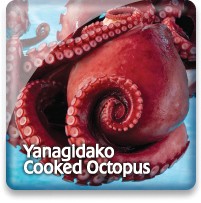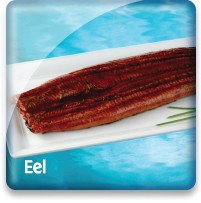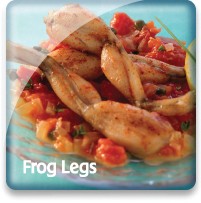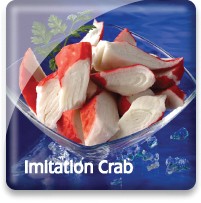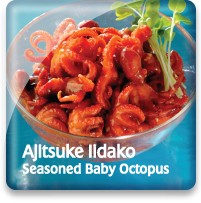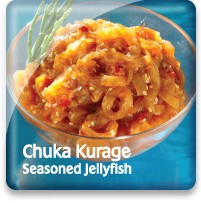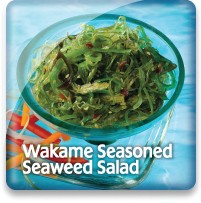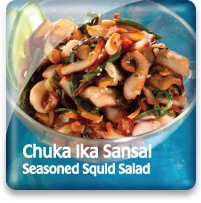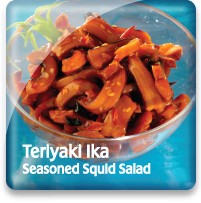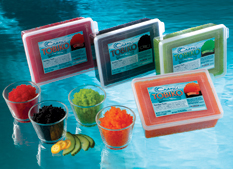
Flying Fish Roe

Market Name:
Scientific Name:
Common Name:
Method of Harvest:
Country of Origin(s): Eating QualitiesFlying Fish Roe is very nutritious and tasty. It is traditionally used in sushi and sashimi preparations. However, it can also be used as a colorful garnish and as an ingredient in various side dishes.
   |
Description & CharacteristicsTobiko is the flavored and colored raw eggs of the flying fish. These eggs (roe) are used in sushi preparations and as a tasty garnish or as an added cooking ingredient. The eggs are collected by fishermen primarily in the spring near the coast of Taiwan when spawning is occurring. The eggs are immediately processed with spices, flavorings, and added coloring to bring out principally 4 brightly colored finished products that are quickly frozen in tubs. These four tobiko colors are black, red, green, and orange. All the colored tobiko have a salty and mildly smoky flavor with a crunchy texture. They are often enhanced with added flavoring such as wasabi and vinegar. Tobiko is around 0.5mm in diameter which is similar in size to caviar.Flying fish are a diverse group of fishes containing more than 60 species. Sea Port attains most of their flying fish eggs from the yellowing and the glider flying fish. Flying fish are distinguished by large pectoral fins that allow them to “fly” for brief periods of time above the surface of the water, often as a way to escape predators. Flying fish feed on plankton and are preyed upon by larger fish, squid, porpoises, and http://cport.net/assets/uploads/files/map.JPGbirds. They launch themselves skyward by wiggling their tails up to 70 times per second and have been known to fly above the water at over 40 mph and for up to a quarter mile. Flying fish generally avoid open ocean waters and are found close to the shorelines of bays and islands in tropical and subtropical regions. The fishery takes place in the northern Taiwan Strait, just south of the East China Sea. Flying fish roe is harvested by taking advantage of the natural behavior of female flying fish to lay their eggs on floating objects or rafts of seaweed. Fishermen create large balls of seaweed which they tie to their vessels, and wait for female flying fish to deposit their eggs. When enough roe has accumulated, the “ball” of seaweed is hauled in and stripped of roe. The fishermen need to be highly skilled and experienced to time their efforts to successfully collect the roe.
Flying fish are very prolific and are therefore thought to be resilient to fishing pressures. However,
To propel itself out of the water, a flying fish must move its tail up to 70 times per second.
Other Resources |
Handling Instructions for Flying Fish Roe
Flying fish roe should be stored frozen at or below 0°F (-18°C) and then thawed properly when ready eat.
Thawing Flying Fish Roe
Our flying fish roe comes in a sealed tub. The roe should remain in the tub as it properly thaws under refrigeration between 35 and 40°F (1.7 to 4 degrees C). Complete thawing is generally accomplished within 24-48 hours.
Important Instructions for Flying Fish Roe
Upon thawing, the flying fish is ready to eat. The refrigerated shelf life is 3-5 days when held under the proper refrigerated temperature range of 35 to 40°F.
Eating Tips
Our flying fish roe is very nutritious and tasty. It is traditionally used in sushi and sashimi preparations. However, it can also be used as a colorful garnish and as an ingredient in various side dishes.
Taiwan
The island of Tawian, shaped like a tobacco leaf, nation, is located off the coast of China where it is officially part of the Republic of China. Some 23 million people live in an area that is just 245 miles long and 89.5 miles wide, making Taiwan the second-most densely populated country in the world.
While it offers few opportunities for recreational fishing, Taiwan’s commercial fishing industry is well-established, with a fleet of vessels that fish around the world for tuna, sharks, herring, reef fish, horse mackerel, sardines, squid and octopus. Aquaculture is also an important new industry in Tawian, with freshwater farms growing shrimp farms, and tilapia, and marine farms growing shellfish such as clams and oysters.
Go Blue! Seafood Sustainability Spectrum*Click here for an explanation of our Sustainability Spectrum 
Sustainability AssessmentFlying Fish are a diverse group of fishes containing more than 60 species. They are distinguished by large pectoral fins that allow them to “fly” for brief periods of time above the surface of the water, often as a way to escape predators. Sea Port sources Flying Fish Roe, also known as tobiko, from Taiwan, where the Yellowing and the Glider Flying Fish are targeted. The fishery takes place in the northern Taiwan Strait, just south of the East China Sea. Flying Fish Roe is harvested by taking advantage of the natural behavior of female Flying Fish to lay their eggs on floating objects or rafts of seaweed. Fishermen create large balls of seaweed which they tie to their vessels, and wait for female Flying Fish to deposit their eggs. When enough roe has accumulated, the “ball” of seaweed is hauled in and stripped of roe. Though this fishery is low impact in terms of bycatch and habitat impacts, there are no stock assessments for Flying Fish in this region. The high value of tobiko and the expanding fishery for adult Flying Fish, combined with the lack of information on stock status and management, are problematic.

Environmental Impact: LowThe fishery for Flying Fish Roe is low-impact and has no known bycatch or negative habitat impacts. However, stock status of adult populations is not known and unmanaged, nor are there any known regulations on the harvest of roe.
Sustainability Improvements NeededHealth of adult Flying Fish populations needs to be monitored to assure they are not overfished, particularly for Yellowing Flying Fish, which have a limited distribution. Appropriate controls on the harvest of roe should be developed to prevent overharvesting.
Actions that Sea Port is UndertakingSea Port is not presently concerned about irresponsible environmental practices for this fishery. It is a highly skilled artisanal fishery that has limited negative environmental impacts. However, we are constantly monitoring the fishery in order to detect any negative changes and we will modify our sourcing activities accordingly if they are observed. Sea Port believes that, in aggregate, choosing from a diverse variety of seafood is better for sustaining the world’s seafood resources and Flying Fish Roe should be a part of this variety. We created the sustainability assessments for each of our seafood items in order to reveal the existing and potential environmental impacts and risks that are associated with producing them for human consumption. This allowed us to establish the starting position for each of our seafood items along our progressive Go Blue! Seafood Sustainability Spectrum®. These assessments are only a single snapshot in time and because of this, we will continue to assess and update the critical sustainability needs associated with our supply sources and issue updates to the Go Blue! Seafood Sustainability Spectrum® as needed. There is a growing global awareness for the need to assure the sustainability of farmed and wild caught seafood and because of this; all around the world positive changes are rapidly occurring at all levels of the seafood supply chain. We will continue to spread this growing awareness and work with our many industry partners to improve the sustainability of all seafood, which we believe is the ideal protein of choice to feed an ever growing world population. Our Go Blue! Seafood Sustainability Spectrum® serves as our compass and yardstick as we strive to move all our products forward to becoming more sustainable. Please join us in this committed quest and Catch Our Wave® to sustainability by choosing a diverse variety of responsibly produced seafood as part of your diet. |



